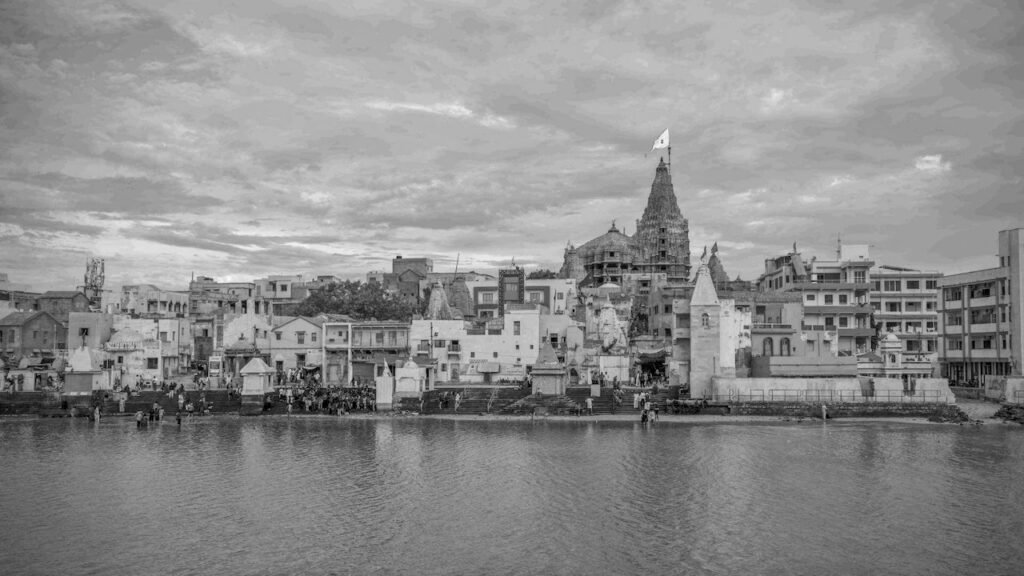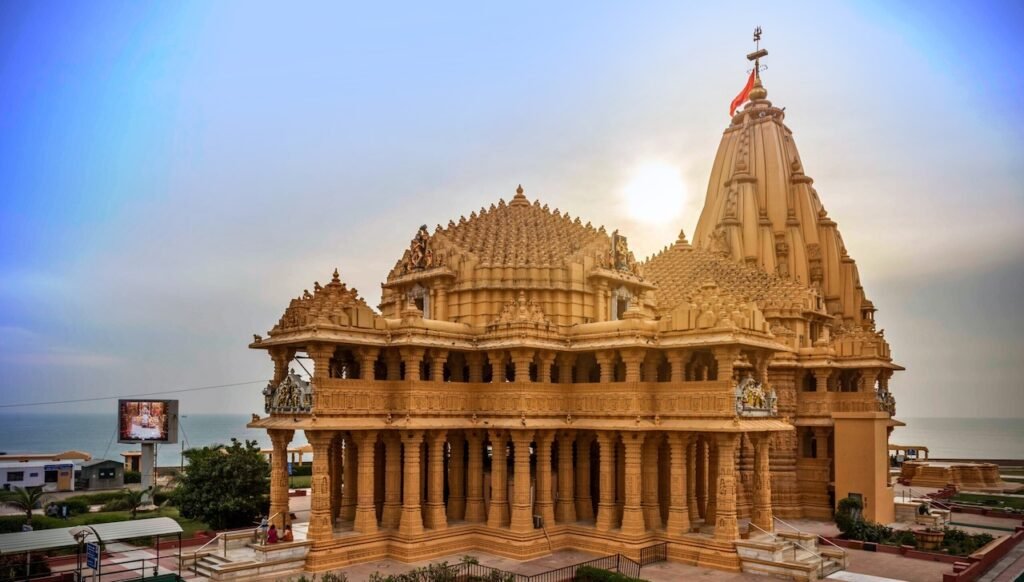The iconic Dwarkadhish Temple in Gujarat’s Dwarka is seeing record numbers of visitors in 2025 following major restoration works and new initiatives aimed at both spiritual preservation and heritage tourism. The temple trust has digitised donation systems for greater transparency, introduced multilingual audio guides, and extended darshan hours to accommodate the growing influx of pilgrims from India and abroad. The city’s infrastructure, roads, hotels, and transport hubs have also expanded, making Dwarka a welcoming gateway for faith-seekers and culture enthusiasts. Local businesses and artisans have reported growth in revenues, and the festival season is expected to surpass previous attendance records, reinforcing Dwarka’s place as a thriving spiritual and cultural hub.
Dwarkadhish Temple: India’s Eternal Gateway to Krishna
The Dwarkadhish Temple, nestled on the coast of Dwarka in Gujarat, stands not only as one of Hinduism’s holiest sanctuaries but as a living chronicle of faith, mythology, and ancient engineering marvels. Revered as the ‘Jagat Mandir’ or ‘Universal Shrine,’ it is dedicated to Lord Krishna, worshipped here as Dwarkadhish, the King of Dwarka.
Darshan usually runs from 7 am to 1 pm and 5 pm to 9:30 pm; timings may vary. This temple forms a cardinal part of the revered Char Dham Yatra and draws seekers, devotees, and travellers from across the globe. Dwarka, believed by legend to be Krishna’s capital, has witnessed the passage of time, tides, and tales. The temple itself is home to thousands of years of living heritage.
Cultural & Spiritual Significance
The Dwarkadhish Temple is one of the four Char Dham pilgrimage sites (alongside Badrinath, Rameswaram, and Puri).
- It also belongs to Sapta Puri, the seven most holy cities in Hinduism.
- Pilgrims ascend 50+ steps to reach the sanctum, passing intricately carved walls that narrate mythical tales.
- Rituals include changing the 52-yard cloth flag atop the 43-meter shikhar five times daily, symbolising perpetual devotion.
Within the sanctum, devotees find Krishna’s idol crafted from black marble, adorned with rich jewels, and poised with his flute. The temple features two main gates: Swarg Dwar (the gateway to heaven for entry) and Moksha Dwar (the gateway to liberation for exit).
Tourist Experience & Nearby Attractions
Dwarka is a major tourist and pilgrimage hub. The experience starts with winding through ancient city lanes, soaking in the spiritual atmosphere, and ascending temple steps. Key attractions nearby include:
- Gomti Ghat: beautiful river-side strolls and views
- Sudama Setu: a picturesque hanging bridge leading to the nearby beach
- Rukmini Devi Temple, Bet Dwarka Island, Nageshwar Jyotirlinga
- Beachfront, local bazaars, museums, and rich heritage sites
Daily Darshan Timings: 7:00 am to 12:30 pm, 5:00 pm to 9:30 pm (please note seasonal variations).
The best time to visit is from October to March, when the climate is pleasant.
How to Reach Dwarkadhish Temple
Dwarka is well-connected by air, rail, and road to major cities:
- By Air: Fly to Jamnagar or Porbandar, then take a taxi/bus.
- By Train: Multiple trains connect Dwarka station to cities like Ahmedabad, Rajkot, and Delhi.
- By Road: State and national highways link Dwarka to the rest of Gujarat and western India. NH-947 offers direct access.
Common travel routes:
| City | Distance to Dwarka | Travel Mode | Approximate Time |
|---|---|---|---|
| Ahmedabad | 448 km | Road/train | 8-9 hours |
| Jamnagar | 131 km | Road/air | 2 hours |
| Porbandar | 108 km | Road/air | 1.5 hours |
| Delhi | 1,100+ km | Train/flight via Rajkot | 18-23 hours |
Location: Where The Sacred Meets The Sea
Dwarkadhish Temple is perched on the banks of the Gomti River, where its grand spire points skyward and its flag flutters with ancient pride. The Arabian Sea lends the setting an ethereal beauty, merging devotion and nature’s splendour. Address: Dwarka, Gujarat, 361335, India.
- Nearest Airport: Jamnagar (131 km)
- Nearest Railway Station: Dwarka (2 km)
- Road Connection: NH-947 directly leads to Dwarka
- Ahmedabad Distance: 448 km (8-hour road trip)
- Delhi Distance: Approx. 1,100 km, accessible by train or flight
Dwarka’s Timeless Sanctum and Significance
Archaeological surveys and ancient scriptures date the original temple as early as 200 BCE. The site, believed to be built by Vajranabh, the great-grandson of Krishna, over Krishna’s erstwhile palace, has survived invasions and natural calamities. The current five-story structure, supported by 72 pillars, took its definitive shape during the 15th and 16th centuries after being rebuilt from destruction.
Significant events in its history:
- Mentioned in the Mahabharata and Skanda Purana as Krishna’s capital
- Destroyed by Mahmud Begada in 1473, it was reconstructed thereafter
- Sacred visit by Adi Shankaracharya, commemorated within the temple
- The city itself is believed to have been submerged multiple times; the present avatar is its seventh.
Temple Architecture: A Marvel in Stone
Built using soft limestone and sand, the temple’s Chalukya-style architecture is visible in its grandeur and intricate design. The five-story main building boasts a towering spire visible from 10 kilometres away and is supported by 72 robust pillars. Artistic carvings of gods, legends, and mythological motifs line the walls, gateways, and porches, creating an immersive visual and spiritual experience within the temple.

Revenue: Dwarka’s Economic and Spiritual Strength
The temple’s economic vitality mirrors its spiritual importance. Donations and temple income:
- In 2019-20, the income was Rs 11.03 crore, which dropped to Rs 6.44 crore during the pandemic closures.
- Income rose again to Rs 13 crore in 2021-22, signalling recovery with growing footfalls.
- In previous years, annual revenue figures have ranged between Rs 8 crore and Rs 9.18 crore.
Thousands of devotees make offerings, and festival seasons drive a spike in both donations and local tourism revenue.
Local Customs, Festivals & Culture
The Dwarkadhish Temple is the epicentre of vibrant festivals, including Janmashtami (Krishna’s birthday), Holi, Diwali, and Annakut, which are celebrated with grand processions, music, dance, and elaborate rituals. The temple’s religious calendar keeps Dwarka buzzing year-round, inviting people to witness ancient Vedic traditions and warm Gujarati hospitality.
The temple trust and local organisations ensure the preservation of rituals, heritage arts, and community welfare, making Dwarka a nurturing ground for India’s living culture.
Preservation, Modern Challenges & Tourism
The Dwarkadhish Temple has withstood centuries of challenges, including earthquakes, invasions, and coastal erosion. Modern preservation and restoration efforts focus on maintaining its architectural and spiritual heritage. Pilgrims and tourists visiting increase pressure but also drive support for conservation, the local economy, and community engagement.
Safety protocols, cleanliness drives, digitisation of donations, and sustainable tourism initiatives are current priorities for trust management.
FAQs About Dwarkadhish Temple, Dwarka
When was the Dwarkadhish Temple built?
Archaeological findings suggest the temple was built as early as 200 BCE, with the current structure dating to the 15th-16th century.
Who founded the temple?
It is believed to have been originally established by Vajranabh, Krishna’s great-grandson, over Krishna’s palace.
What are the Char Dham pilgrimage sites?
The Char Dham comprises Dwarka, Badrinath, Rameswaram, and Puri, four sacred destinations for Hindus.
How is the temple’s flag significant?
The cloth flag atop the temple is 52 yards long, changed five times daily, and symbolises Krishna’s perpetual presence.
What is the best way to reach Dwarka?
The temple can be reached by air via Jamnagar, by train to Dwarka station, or by road via NH-947 from major cities.
What are the temple timings?
Darshan usually runs from 7 am to 1 pm and 5 pm to 9:30 pm; timings may vary.
How much revenue does the temple generate?
In recent years, annual revenues of Rs 8-13 crore have been generated from donations and offerings.
What are the main attractions nearby?
Gomti Ghat, Sudama Setu, Bet Dwarka, Nageshwar Jyotirlinga, and the city’s beautiful beach make memorable excursions.
